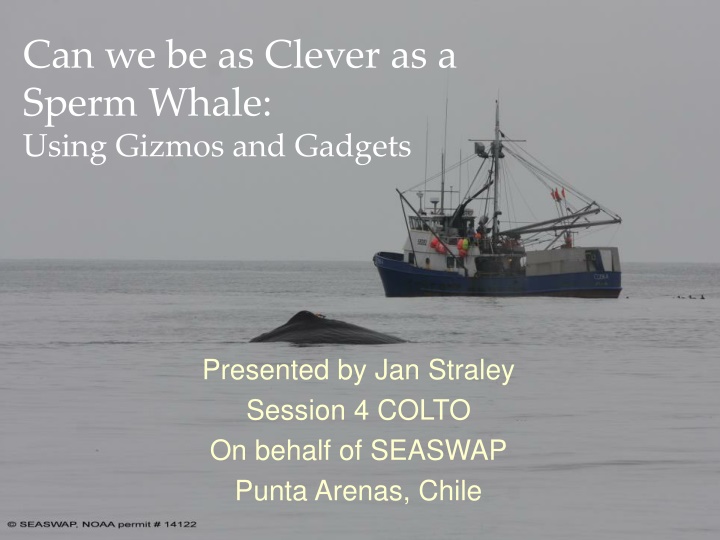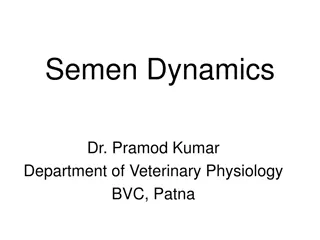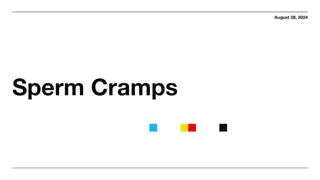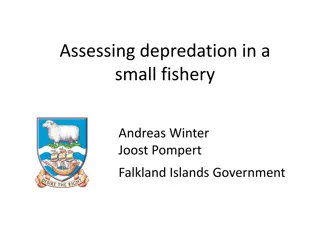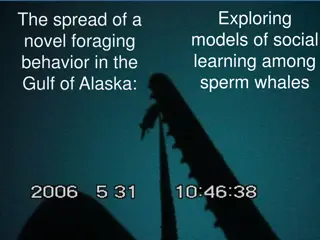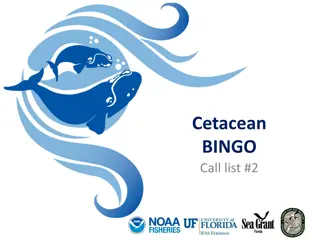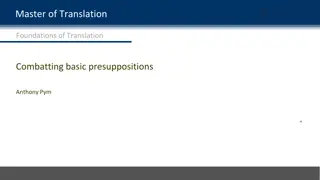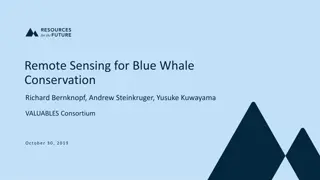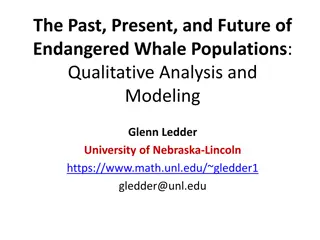Can We Be as Clever as a Sperm Whale?: Using Gizmos and Gadgets in Combatting Sperm Whale Depredation
Explore the innovative strategies employed by the Southeast Alaska Sperm Whale Avoidance Project (SEASWAP) to reduce sperm whale depredation on fishing gear in the Gulf of Alaska. Through acoustics and decoys, researchers aim to deter whales from longline hauls, ultimately protecting the marine ecosystem and fisheries. The collaborative efforts between scientists, fishermen, and fisheries managers showcase the potential for human ingenuity to address complex ecological challenges.
Download Presentation

Please find below an Image/Link to download the presentation.
The content on the website is provided AS IS for your information and personal use only. It may not be sold, licensed, or shared on other websites without obtaining consent from the author.If you encounter any issues during the download, it is possible that the publisher has removed the file from their server.
You are allowed to download the files provided on this website for personal or commercial use, subject to the condition that they are used lawfully. All files are the property of their respective owners.
The content on the website is provided AS IS for your information and personal use only. It may not be sold, licensed, or shared on other websites without obtaining consent from the author.
E N D
Presentation Transcript
Can we be as Clever as a Sperm Whale: Using Gizmos and Gadgets { Presented by Jan Straley Session 4 COLTO On behalf of SEASWAP Punta Arenas, Chile
Field Trials of an Acoustic Decoy { Goal: Reduce Sperm Whale Depredation on Demersal Longlines in the Gulf of Alaska Lauren Wild, Aaron Thode, Jan Straley, Linda Behnken, Dan Falvey, Tory O Connell, Joe Liddle
Sperm whales remove fish, depredate, from commercial fishing gear worldwide. Gulf of Alaska: targeting longline fishing vessels catching black cod (sablefish)
Reported since 1970s Encounters becoming more frequent
Southeast Alaska Sperm Whale Avoidance Project (SEASWAP) www.seaswap.info Cooperative research between scientists, fishermen, and fisheries managers
Acoustics Acoustically active Constantly producing echolocation signals. Photos: SEASWAP s acoustic recorders over the last 10 years
Acoustic Cue: Engine Cycling Thode et al. 2007 Propeller Cavitation Engine Engages 0-10kHz Engine in neutral, 0-2kHz Thode et al. 2007, JASA
Acoustic Decoy: Can we delay whales arrival at the fishing haul by attracting them elsewhere?
Acoustic Decoys: can we be as clever as a sperm whale? Playbacks designed to deter whales from longline haul Not effective (2009) Decoy designed to attract whales away from the true longline haul
Decoy: experimental design Autonomous playback device fitted with 3-min clips of engine cycling from a SEASWAP member vessel. VHF communication allows captains to remotely activate playback from up to 10nm away Speaker capabilities: Frequency range = 250Hz-20kHz SPL = 194dB/uPa/m @ 10.6kHz Depth=5-20ft. Playback device, custom design SEASWAP Acoustic Lab, Scripps Institution of Oceanography Decoy speakers (Lubell LL9162T)
Decoy Deployment: Varying distances of decoy from true fishing set: Between 1-10nm Decoy True fishing set Playback device & underwater speaker (20m depth) Acoustic recorder (200-300m depth): Confirm whale presence at fishing haul. Acoustic recorder (200-300m depth): Confirm decoy operation & whale presence in vicinity of Decoy Groundline with hooks on fishing set
Decoy: Summer 2013 Trials Single vessel: F/V Magia, skipper Stephen Rhoads Single area: Western Gulf of Alaska 28 deployments 14 usable sets
Decoy analysis: detecting whales with acoustics Long-term averaged spectrograms allow us to look at whale activity over long periods of time 10:24am Decoy activates Recorder at Decoy Decoy ON Distant whale activity
Decoy analysis: detecting whales with acoustics Heavy whale activity during haul Minimal to no whale activity
Decoy Results: 14 successful trials Whales at Decoy Only
Decoy Results: Generalized Linear Model (Poisson) The farther away the decoy was from the fishing haul, the fewer whales showed up at the haul. p = 0.039, significant at the 5% level
Decoy Results: Normal GLM Time between decoy activation and first whale detected at fishing haul (decoy-haul-delay time) Whale delay in arriving at the haul increased when decoy farther away Smaller sample size n=8 p = 0.05, significant at the 5% level
Conclusions: Successes May be first demonstration of an acoustic decoy on marine mammals Distance is key farther decoy => fewer whales arrive Sometimes whales stayed at decoy and never approached true fishing haul. Conclusions: Caveats Applicable to a limited set of circumstances: - Whales must be known to be present. - Fishing vessel is alone. Testing requires intersection of fishermen, whales, and fish: Mr. Rhoads took device again in 2014 to collect more data: 2 months at sea saw no whales, did not deploy decoy. Device is heavy and awkward hard to maneuver on vessel -Further engineering effort would be required -Wider number of vessel samples to reduce habituation risk.
Photo Credit: Dick Curran, F/V Cherokee Thank You! Skippers: Dan Falvey, Stephen Rhoads, Walt Pasternak Crew members on F/V Myriad, F/V Christi-Rob, & F/V Magia www.seaswap.info Thursday 14:15, Aaron Thode Continental Ballroom 1-4 SEASWAP Go-Pros
